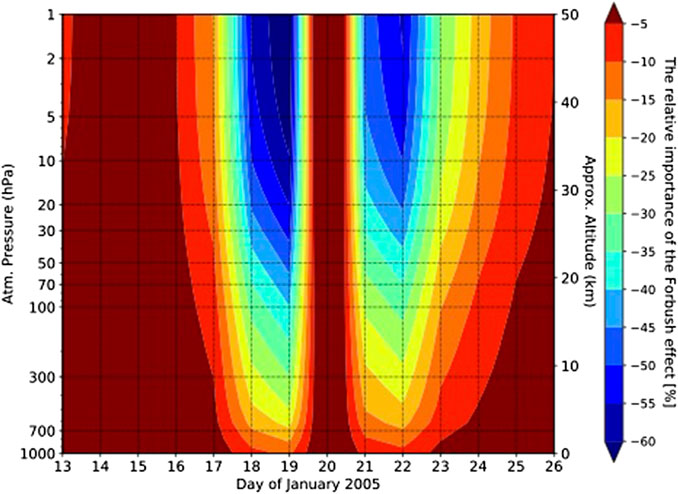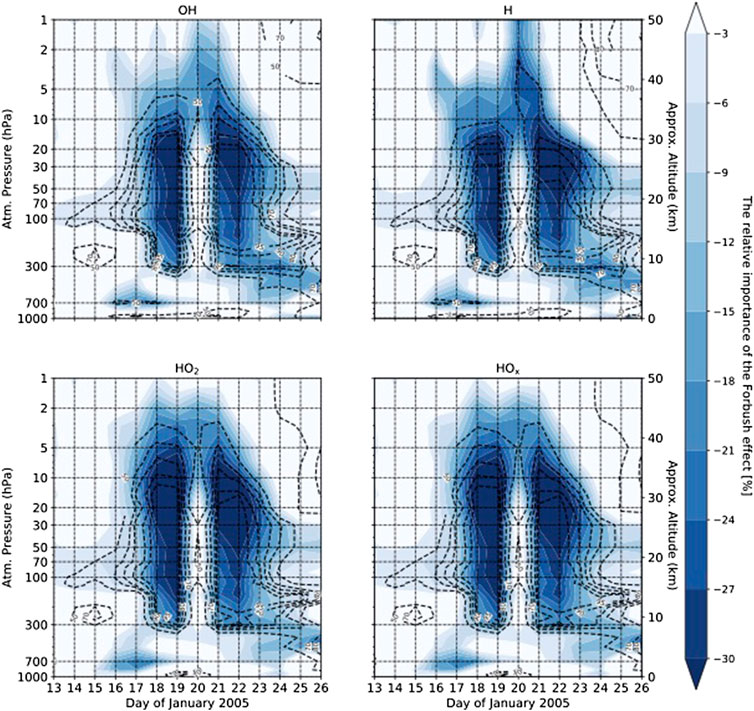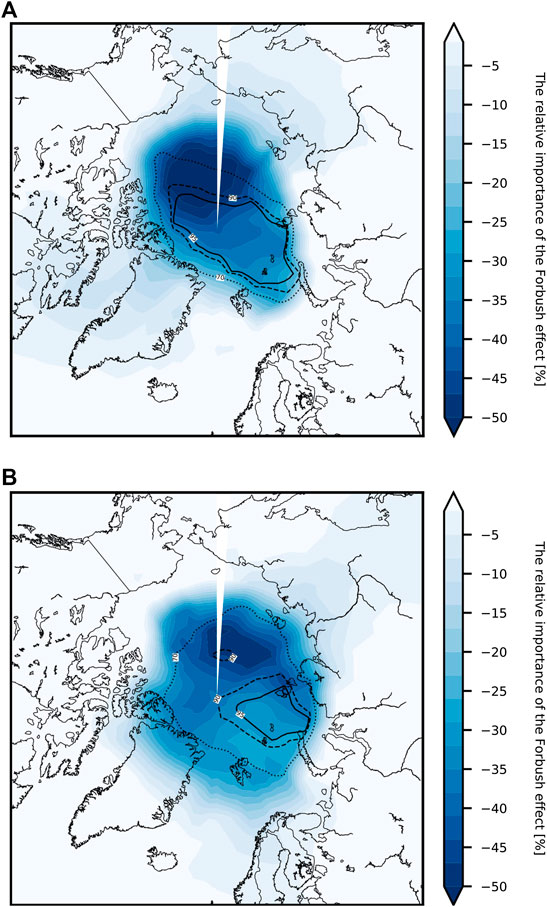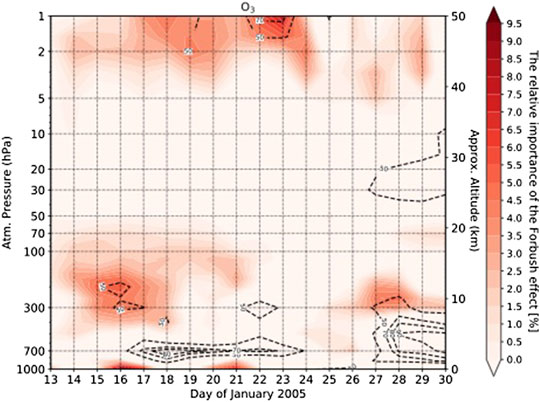- 1Department of Physics of Earth, Faculty of Physics, Saint Petersburg State University, Saint Petersburg, Russia
- 2National Research Nuclear University MEPhI, Moscow, Russia
- 3Physikalisch-Meteorologisches Observatorium World Radiation Center, Davos and IAC ETH, Zurich, Switzerland
It is well-known that energetic particle precipitations during solar proton events increase ionization rates in the middle atmosphere enhancing the production of hydrogen oxide radicals (HOx) involved in the catalytic ozone destruction cycle. There are many studies where the contribution of energetic particles to the formation of hydrogen oxide radicals and ozone loss has been widely investigated. However, until now, there was no solid evidence that the reduction in galactic cosmic ray fluxes during a magnetic storm, known as Forbush-effect, directly and noticeably affects the polar-night stratospheric chemistry. Here, the impact of the Forbush decrease on the behavior of hydrogen oxide radicals was explored using the chemistry-climate model SOCOLv2. We found that hydrogen oxide radical lost about half of its concentration over the polar boreal night stratosphere owing to a reduction in ionization rates caused by Forbush decreases after solar proton events occurred on 17 and 20 of January 2005. The robust response in ozone was not found. There is not any statistically significant response in (NOx) on Forbush decrease events as well as over summer time in the southern polar region. The results of this study can be used to increase the veracity of ozone loss estimation if stronger Forbush events can have place.
1 Introduction
Sporadically occurring strong increases in the intensity of energetic particles precipitation (EPP) can sufficiently enhance the ionization of the Earth polar atmosphere leading to the additional production of the odd hydrogen (HOx = H + OH + HO2) and odd nitrogen (NOx = N + NO + NO2) species (Crutzen et al., 1975; Solomon et al., 1981). The chemical lifetime of HOx is relatively short (less than an hour), therefore their enhancement is highly localized in time and space, and can be observed only during EPP events in the region where the enhance in ionization occurs. The OH radical is the principal atmospheric oxidant, affecting both aerosols and ozone in complex ways. Moreover, under nighttime conditions when there is no UV-induced effect on atmospheric chemistry, the low background in HOx allows particles-induced changes to be clearly identified. The main processes responsible for the HOx formation were broadly described by Porter et al. (1976); Solomon et al. (1981); Aikin (1994), and more recently by Sinnhuber et al. (2012). Both, HOx and NOx play a fundamental role in the ozone balance by driving efficient catalytic cycles of O3 destruction. NOx is a more stable species with a chemical lifetime of more than a month and can be transported by atmospheric circulation away from the region of its formation, therefore NOx enhancement can be observed also after EPP events and far away from the production area (e.g., Funke et al., 2005, 2017; Sinnhuber et al., 2011). The ozone response to HOx and NOx enhancements depend on the altitude as well as on the horizontal and vertical air mass redistribution within the polar vortex. More information on the EPP effect on the ozone layer can be found in recent publications (Rozanov et al., 2012; Sinnhuber et al., 2012; Mironova et al., 2015). During the earthward coronal mass ejection, when the strong increase in solar cosmic rays is observed, a large perturbation of the interplanetary geomagnetic field can strongly reflect the galactic cosmic rays fluxes resulting in the so-called Forbush decrease (FD) (Forbush, 1958). The galactic cosmic rays (GCR) intensity following coronal mass ejection can drop by about a few to tens of percentage as observed by ground-based detectors (Cane, 2000; Oh and Yi, 2012). The FD can, in principle, have an atmospheric effect as modifying the cloud cover through the reduction of nucleation rate hence on local polar meteorology and climate as assumed in Todd and Kniveton (2001); Laken and Kniveton (2009). However, there is no solid evidence found that such FD events can impact atmospheric chemistry as the ionization effect is quite small as opposed to solar energetic particle (SEP) related effects so the chemical response on FD is barely able to be found in observations. Therefore, only numerical tools like chemistry-climate models can provide an estimation of the FD effect on atmospheric chemistry since giving feasibility to design an experiment with only GCR ionization included avoiding thereby a strong chemical response on ionization from SEP. In this work, we focus on determining the response in the chemical composition of the polar atmosphere, namely the odd hydrogen (HOx = H + OH + HO2) and ozone during Forbush events in January 2005. In section 2 the ionization rates during January 2005 and particularly Forbush effects will be discussed. In section 3, the general description of the chemistry-climate model SOCOL and details on conducted experiments are given. The results of this work are presented in section 4. The work is concluded with section 5 containing the discussion and summary.
2 The Ionization of the Polar Atmosphere During January 2005. The Forbush‐Effect
During the second half of January 2005, several solar energetic particle events and Forbush decreases of galactic cosmic rays were observed. On the 16th of January, a series of solar energetic particle events started following the X2.6 class flare observed on the previous day. On the next day (17th of January) a coronal mass ejection (CME) and a stronger X3.8 flare occurred. On January 17, 2005, the GOES satellite recorded the maximum flux of particles with energies more than 10 MeV. Particles with energies more than 100 MeV were observed on the GOES satellite on January 20, 2005.1 The X7 flare and CME that occurred on 20th January produced the hardest and the most energetic proton event of the 23rd solar activity cycle observed as a Ground Level Enhancement (GLE) event by the worldwide network of neutron monitors.2 A rapid decrease in the observed galactic cosmic ray intensity followed a coronal mass ejection and SEP events. Major FDs are usually accompanied by strong geomagnetic disturbances, which suppress the local geomagnetic field. The FDs during January 2005 was associated with strongly enhanced geomagnetic activity. Geomagnetic conditions characterized by geomagnetic indices showed a sufficiently disturbing level (Dst - 103 nT, and Kp increased to 8).3 18th and 21st of January the worldwide network of neutron monitors (NM) recorded a significant decrease in the counting rate. Forbush decreases caused by an interplanetary disturbance on the January 18, 2005, was a strong 15% decrease of galactic cosmic ray flux and January 21, 2005 Forbush decrease was about 10% (Papaioannou et al., 2010). Atmospheric ionization during these SEP events and Forbush decreases was discussed in great detail by Usoskin et al. (2011). It is shown that the direct ionization GLE effect can be negative, due to the accompanying Forbush decreases, especially in all low- and mid-latitude regions.
Figure 1 presents the GCR induced ionization rates (IRgcr) change with respect to the ionization rates of 1st of January 2005 (IRref) for the region covering 75–90° North and South hemispheres. In Figure 1 ionization rates in percentage is calculated as: ((IRgcr - IRref)/IRref)*100%. Figure 1 illustrates ionization rate changes in the atmosphere for the second half of January 2005.4 During the 18th and January 21, 2005 ionization rates slightly decline to show a decrease by about 5–10 ion-pairs/cm3/s compared to the difference with 1st of January 2005 during a quiet period. The presented in Figure 1 GCR induced ionization rates were calculated using the CRAC: CRII (Cosmic Ray induced Atmospheric Cascade: application for Cosmic Ray Induced Ionization) model (Usoskin and Kovaltsov, 2006; Usoskin et al., 2010; Usoskin et al., 2011).

FIGURE 1. The GCR induced ionization rates (IR) change with respect to the January 1, 2005 are presented for the polar atmosphere (covering 90N-75N).
In this study, the Forbush-related effect on the behavior of HOx radicals and ozone was explored using the chemistry-climate model SOCOLv2.
3 The CCM Socol Description and Experiments Set-Up
In this study, we used the chemistry-climate model (CCM) SOCOLv2 (modeling tool for SOlar Climate Ozone Links) (Schraner et al., 2008). The CCM SOCOL is a combination of the fourth-generation general circulation model (GCM) MA-ECHAM4 (Manzini et al., 1997) and the chemistry transport model (CTM) MEZON (Rozanov et al., 1999; Egorova et al., 2005). These models are interactively-coupled within the SOCOL through O3, temperature, wind, green-house gases, and ozone-depleting substances. Both MA-ECHAM4 and MEZON have the same vertical and horizontal resolution. The CCM SOCOLv2 treats 41 chemical species of oxygen, hydrogen, nitrogen, carbon, chlorine, and bromine groups, which are determined by 140 gas-phase reactions, 46 photolysis reactions, and 16 heterogeneous reactions in/on aqueous sulfuric acid aerosols, water ice, and nitric acid trihydrate.
In this study, we performed two ten-member ensemble experiments for January 2005 driven by the prescribed evolution of ionization rates. We performed the experiment where only GCR-induced ionization during January 2005 was included (name the experiment as GCRexp) and also carried out the reference experiment applying a constant background ionization level to the entire period of integration which was opted to be the ionization rate for the 1st of January 2005 (name the experiment as REFexp). After, the Student test was applied between ten ensemble members to verify the robustness of the obtained results. All simulations have been performed in free-running mode, i.e. the model dynamic is performed without forcing by prescribed meteorological fields from reanalysis data.
4 The Response in Hox and Ozone During Forbush Decrease on 18th and 21st of January 2005
The HOx family is a good indicator of SEP events because its response to the ionization rate enhancement is fast, strong, and spatially and temporally localized (Solomon et al., 1981; Aikin, 1994; Damiani et al., 2010; Sinnhuber et al., 2012). The odd hydrogen species (HOx), and particularly the hydroxyl radical (OH), play a key role in ozone destruction especially in the mesosphere, and in the lower stratosphere and troposphere (Brasseur and Solomon, 2005). The reason for that is related to efficient catalytic cycles of ozone destruction (Bates and Nicolet, 1950; Brasseur and Solomon, 2005). Here we analyze the response of HOx radicals and ozone, simulated by the CCM SOCOLv2, to implied variability of ionization rates over the northern polar region during January 2005. In this work, we aimed at determining the response of HOx radicals and ozone on declining ionization during the Forbush decreases on the 18th and January 21, 2005.
The simulated vertical profiles of the relative importance of the Forbush‐effect in components of HOx over the northern polar stratosphere (averaged over 75–90° North) during the period affected by the SEP events and Forbush decreases obtained by CCM SOCOLv2 are presented in Figure 2. The deviation from the quiet period or reference run is shown in (%). The relative importance presented in Figure 2 is calculated as: ((HOxgcr - HOxref)/HOxref)*100%, where: HOxgcr from the experiment GCRexp where the GCR induced ionization was only included and the HOxref is from the reference experiment REFexp where a constant ionization level at January 1, 2005 was applied. On the 18th and January 21, 2005, the strong HOx decreasing of more than 30% is seen following the weaker ionization induced by Forbush decreases caused by an interplanetary disturbance on these days (see the ionization response in Figure 1). The effect of HOx decrease is noticeable in the middle and lower stratosphere and the upper troposphere where the ionization from SEPs are negligible. The geographic regions, where the decreasing of HOx up to 50% were found, is shown in Figure 3. The effect in HOx is statistically robust showing more than 95% of statistical significance. The ozone variability calculated in the same way with HOx is presented in Figure 4. In our study, we did not find any solid and statistically robust response in ozone to changes in HOx induced by Forbush decrease. It should be noted that two spots of increased ozone are seen over the upper stratosphere at the next day following the decrease of HOx concentration during both FD events. However, this effect is hardly likely associated with FD as it is seen above the response in HOx. The absence of solid response can be explained by a longer chemical lifetime of O3 in the region affected by Forbush decrease.

FIGURE 2. The vertical profiles of temporal evaluations of anomalies in HOx over the northern polar atmosphere (90N-75N) during the period affected by Forbush decreases simulated with CCM SOCOLv2. The name of each HOx component is given above each panel. Dashed lines: the confidence level [in %].

FIGURE 3. The polar distribution of Forbush-induced effect in HOx simulated with CCM SOCOLv2 averaged for 1–300 hPa (A) January 18, 2005; (B) January 21, 2005. Solid line: area with confidence level of 95%. Dashed line: area with confidence level 90%; dotted line: area with confidence level 70%.

FIGURE 4. The ozone effect induced by a strong decrease in HOx radical over the northern polar atmosphere (90N-75N) during Forbush decreases of January 2005. Dashed lines: the confidence level [in %].
5 Discussion and Summary
In this work, the contribution of the reduced GCR-induced ionization caused by the Forbush decrease in January 2005 to the changes in the polar-night concentration of H, OH, and HO2 (HOx) and ozone were explored. The main goal of this study is to demonstrate the estimated strength of the response in atmospheric chemistry and to show the connection of obtained response to the reduced ionization during Forbush decreases. To obtain the Forbush-related effects in odd hydrogen (HOx) and ozone, we conducted several numerical experiments using the CCM SOCOL including the experiment where the GCR induced ionization during January 2005 was only included and the reference experiment where a constant ionization level at January 1, 2005 was applied for the whole month. The Forbush decrease-related effects on HOx were obtained during the polar-night (over 90N-75N) with a statistical significance of more than 95%. Our analysis demonstrates a substantial decline in HOx concentration (∼50%) during both Forbush decreases occur on the 18th and 21st of January 2005 accounting for about half of its total concentration at heights affected by Forbush events. Despite the effect in HOx is clearly seen, the robust response in O3 was not found. The reason could be in the chemical lifetime of O3 that is more than a month and the immediate effect in these compounds can not be observed in the time of Forbush decrease. The same could be said about NOx radical which was also examined in the course of the study, however, any statistically significant response was not found. The catalytic cycle involving NOx is for sure the most efficient in the middle stratosphere. Some decrease of NOx during the Forbush event can be expected, but we do not see it in the model because it is masked by internal variability caused by other (more efficient) chemical and transport processes. HOx decrease is more visible because the transport processes are less important due to the much shorter HOx life-time. It is possible that if analyzing the FD induced by stronger 775 AD-like events, the solid response in other chemical compounds might be observable. It should be also noted that here we did not attempt to find any responses on FD events over the southern polar region since, in the presence of UV-radiation during day-time, the particle-related effects can not be identified.
In the course of this work, for the first time it was shown that not only an increase in ionization during solar proton event events can affect the concentration of HOx radicals in the middle atmosphere, but also a decrease in GCR induced ionization resulted from the Forbush decrease can lead to noticeable changes in the whole HOx family over the middle and lower stratosphere. How it is shown in our study, the Forbush-related effect on ozone in January 2005 is probably diminutive in comparison with ozone depletion related to solar proton events, which can lead to a massive increase in the middle atmospheric HOx concentration by a hundred percents. Further work is needed to more precisely identify the FD-related effects in other species including ozone using more accurate tools and chose stronger Forbush events for such analysis.
Data Availability Statement
The raw data supporting the conclusions of this article will be made available by the authors, without undue reservation.
Author Contributions
IM: the main goal of the study; ER and IM: experimental setups, CCM SOCOL model runs; IM and AK-D: data processing; AK-D: figures preparation; IM, AK-D, and ER: writing the manuscript.
Funding
The study was supported by the Russian Science Foundation grant (RSF project No. 20-67-46016).
Conflict of Interest
The authors declare that the research was conducted in the absence of any commercial or financial relationships that could be construed as a potential conflict of interest.
Footnotes
1NOAA list of solar proton events database and class flares: http://umbra.nascom.nasa.gov/SEP/.
2GLE events detected by neutron monitors can be found at: http://www01.nmdb.eu/ and https://gle.oulu.fi.
3Space weather conditions were derived from: https://omniweb.gsfc.nasa.gov/.
4Forbush effect seems to be stronger in the upper stratosphere since the background number of ion-pairs/cm3/s on the top is less than in the troposphere.
References
Aikin, A. C. (1994). Energetic particle-induced enhancements of stratospheric nitric acid. Geophys. Res. Lett. 21, 859–862. doi:10.1029/94GL00914
Bates, D. R., and Nicolet, M. (1950). The photochemistry of atmospheric water vapor. J. Geophys. Res. 55, 301–327. doi:10.1029/JZ055i003p00301
Brasseur, G. P., and Solomon, S. (2005). Aeronomy of the middle atmosphere. 3rd. 3300 AA Dordrecht, The Netherlands: Springer.
Cane, H. V. (2000). Coronal mass ejections and Forbush decreases. Space Sci. Rev. 93, 55–77. doi:10.1023/A:1026532125747
Crutzen, P. J., Isaksen, I. S. A., and Reid, G. C. (1975). Solar proton events - stratospheric sources of nitric oxide. Science. 189, 457–459. doi:10.1126/science.189.4201.457
Damiani, A., Storini, M., Rafanelli, C., and Diego, P. (2010). The hydroxyl radical as an indicator of SEP fluxes in the high-latitude terrestrial atmosphere. Adv. Space Res. 46, 1225–1235. doi:10.1016/j.asr.2010.06.022
Egorova, T., Rozanov, E., Zubov, V., Manzini, E., Schmutz, W., and Peter, T. (2005). Chemistry-climate model SOCOL: a validation of the present-day climatology. Atmos. Chem. Phys. 5, 1557–1576. doi:10.5194/acpd-5-509-2005
Forbush, S. E. (1958). Cosmic-ray intensity variations during two solar cycles. J. Geophys. Res. 63, 651–669. doi:10.1029/JZ063i004p00651
Funke, B., Ball, W., Bender, S., Gardini, A., Harvey, V. L., Lambert, A., et al. (2017). HEPPA-II model-measurement intercomparison project: EPP indirect effects during the dynamically perturbed NH winter 2008-2009. Atmos. Chem. Phys. 17, 3573–3604. doi:10.5194/acp-17-3573-2017
Funke, B., López-Puertas, M., Gil-López, S., von Clarmann, T., Stiller, G. P., Fischer, H., et al. (2005). Downward transport of upper atmospheric NOx into the polar stratosphere and lower mesosphere during the Antarctic 2003 and Arctic 2002/2003 winters. J. Geophys. Res. 110, D24308. doi:10.1029/2005JD006463
Laken, B. A., and Kniveton, D. R. (2009). The effects of Forbush decreases on Antarctic climate variability: a re-assessment. Atmos. Chem. Phys. Discuss. 9, 10575–10596. doi:10.5194/acpd-9-10575-2009
Manzini, E., McFarlane, N. A., and McLandress, C. (1997). Impact of the Doppler spread parameterization on the simulation of the middle atmosphere circulation using the MA/ECHAM4 general circulation model. J. Geophys. Res. 102, 25751. doi:10.1029/97JD01096
Mironova, I. A., Aplin, K. L., Arnold, F., Bazilevskaya, G. A., Harrison, R. G., Krivolutsky, A. A., et al. (2015). Energetic particle influence on the Earth’s atmosphere. Space Sci. Rev. 194, 1–96. doi:10.1007/s11214-015-0185-4
Oh, S. Y., and Yi, Y. (2012). A simultaneous Forbush decrease associated with an earthward coronal mass ejection observed by STEREO. Sol. Phys. 280, 197–204. doi:10.1007/s11207-012-0053-2
Papaioannou, A., Malandraki, O., Belov, A., Skoug, R., Mavromichalaki, H., Eroshenko, E., et al. (2010). On the analysis of the complex Forbush decreases of January 2005. Sol. Phys. 266, 181–193. doi:10.1007/s11207-010-9601-9
Porter, H. S., Jackman, C. H., and Green, A. E. S. (1976). Efficiencies for production of atomic nitrogen and oxygen by relativistic proton impact in air. J. Chem. Phys. 65, 154–167. doi:10.1063/1.432812
Rozanov, E., Calisto, M., Egorova, T., Peter, T., and Schmutz, W. (2012). Influence of the precipitating energetic particles on atmospheric chemistry and climate. Surv. Geophys. 33, 483–501. doi:10.1007/s10712-012-9192-0
Rozanov, E. V., Zubov, V. A., Schlesinger, M. E., Yang, F., and Andronova, N. G. (1999). The UIUC three-dimensional stratospheric chemical transport model: description and evaluation of the simulated source gases and ozone. J. Geophys. Res. 104, 11755. doi:10.1029/1999JD900138
Schraner, M., Rozanov, E., Schnadt Poberaj, C., Kenzelmann, P., Fischer, A. M., Zubov, V., et al. (2008). Technical note: chemistry-climate model socol: version 2.0 with improved transport and chemistry/microphysics schemes. Atmos. Chem. Phys. 8, 5957–5974. doi:10.5194/acp-8-5957-2008
Sinnhuber, M., Kazeminejad, S., and Wissing, J. M. (2011). Interannual variation of NOx from the lower thermosphere to the upper stratosphere in the years 1991–2005. J. Geophys. Res. 116, A02312. doi:10.1029/2010JA015825
Sinnhuber, M., Nieder, H., and Wieters, N. (2012). Energetic particle precipitation and the chemistry of the mesosphere/lower thermosphere. Surv. Geophys. 33, 1281–1334. doi:10.1007/s10712-012-9201-3
Solomon, S., Rusch, D. W., Gerard, J.-C., Reid, G. C., and Crutzen, P. J. (1981). The effect of particle precipitation events on the neutral and ion chemistry of the middle atmosphere. ii - odd hydrogen. Planet. Space Sci. 29, 885–893. doi:10.1016/0032-0633(81)90078-7
Todd, M. C., and Kniveton, D. R. (2001). Changes in cloud cover associated with Forbush decreases of galactic cosmic rays. J. Geophys. Res. 106, 32031–32042. doi:10.1029/2001JD000405
Usoskin, I. G., and Kovaltsov, G. A. (2006). Cosmic ray induced ionization in the atmosphere: full modeling and practical applications. J. Geophys. Res. 111, D21206. doi:10.1029/2006JD007150
Usoskin, I. G., Kovaltsov, G. A., and Mironova, I. A. (2010). Cosmic ray induced ionization model CRAC:CRII: an extension to the upper atmosphere. J. Geophys. Res. 115, D10302. doi:10.1029/2009JD013142
Keywords: forbush decreases, Ionization of the stratosphere, galactic cosmic rays, Energetic particle precipitation, stratospheric chemistry, hox, ozone
Citation: Mironova I, Karagodin-Doyennel A and Rozanov E (2021) The Effect of Forbush Decreases on the Polar-Night HOx Concentration Affecting Stratospheric Ozone. Front. Earth Sci. 8:618583. doi: 10.3389/feart.2020.618583
Received: 17 October 2020; Accepted: 02 December 2020;
Published: 14 January 2021.
Edited by:
Jane Liu, University of Toronto, CanadaReviewed by:
Christine Smith-Johnsen, University of Bergen, NorwayJean-Baptiste Renard, UMR7328 Laboratoire de physique et chimie de l’environnement et de l’Espace (LPC2E), France
Copyright © 2021 Mironova, Karagodin-Doyennel and Rozanov. This is an open-access article distributed under the terms of the Creative Commons Attribution License (CC BY). The use, distribution or reproduction in other forums is permitted, provided the original author(s) and the copyright owner(s) are credited and that the original publication in this journal is cited, in accordance with accepted academic practice. No use, distribution or reproduction is permitted which does not comply with these terms.
*Correspondence: Irina Mironova, aS5hLm1pcm9ub3ZhQHNwYnUucnU=
 Irina Mironova
Irina Mironova Arseniy Karagodin-Doyennel
Arseniy Karagodin-Doyennel Eugene Rozanov1,3
Eugene Rozanov1,3